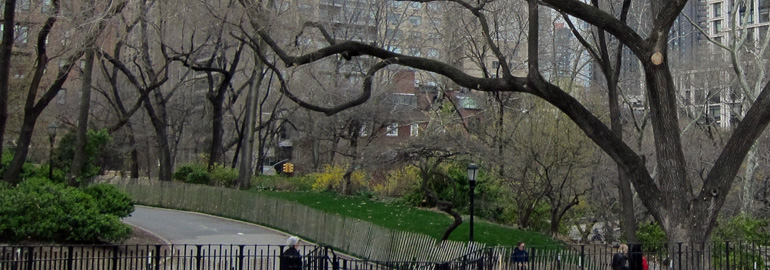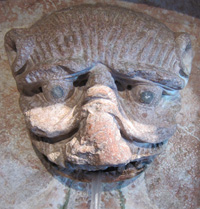 Kathleen is en route to Amsterdam. (What a great time to be traveling, eh?) A long time ago, we planned a trip that would have taken us to London and Paris for a few madcap days on either side of the conference that brings Kathleen to the Nederlander capital, but by the time Kathleen got round to looking for firm upgrades on coach-to-business seats, there were none to be had. So that was the end of the trip for me, and the end of everything but Amsterdam for Kathleen. She’ll be home on Saturday, by which time I’ll have accomplished few if any of the many things on the to-do list that I always compile for Kathleen’s absences. I imagine that, undistracted by the need to make dinner or whatnot (and there really isn’t very much in the way of whatnot when it comes to looking after Kathleen; she is decidedly a kitty and not a puppy), I’ll throw myself into grands projets. But it never happens. I’m just despondent when she’s away, Mr Pillar-to-Post. Oh, I worry about her flights and fly into panics when I can’t get her on the phone, but there’s more to it than that, a low hum of not-quite-right. I think that travel is great, but it should take place while I’m asleep or otherwise unconscious. Otherwise, I want the people in my life to be in New York, most especially Kathleen.Â
Kathleen is en route to Amsterdam. (What a great time to be traveling, eh?) A long time ago, we planned a trip that would have taken us to London and Paris for a few madcap days on either side of the conference that brings Kathleen to the Nederlander capital, but by the time Kathleen got round to looking for firm upgrades on coach-to-business seats, there were none to be had. So that was the end of the trip for me, and the end of everything but Amsterdam for Kathleen. She’ll be home on Saturday, by which time I’ll have accomplished few if any of the many things on the to-do list that I always compile for Kathleen’s absences. I imagine that, undistracted by the need to make dinner or whatnot (and there really isn’t very much in the way of whatnot when it comes to looking after Kathleen; she is decidedly a kitty and not a puppy), I’ll throw myself into grands projets. But it never happens. I’m just despondent when she’s away, Mr Pillar-to-Post. Oh, I worry about her flights and fly into panics when I can’t get her on the phone, but there’s more to it than that, a low hum of not-quite-right. I think that travel is great, but it should take place while I’m asleep or otherwise unconscious. Otherwise, I want the people in my life to be in New York, most especially Kathleen.Â
This time, the inertia set in before Kathleen even left the office. I spent what was supposed to be a day at home, reading, writing, tidying, organizing, and perhaps even menu planning — instead of all that, I goofed off. After some fiddling around with a bonsai tree out on the balcony (one of Kathleen’s discards, partly because she didn’t like the tree itself but mostly because it arrived in a broken pot), I had lunch with WWW. Having just paid the bills, I was in no mood for retail experiences, but as soon as I got home I remembered that Helen has just returned to the Morning Calm Gallery from a family visit abroad. Now she could help me frame some of the pictures that I’ve been stockpiling in recent months. I’d start with the three prints of Christian Chaize’s Praia Piquinia series that I’ve bought at Jen Bekman’s 20×200. There are forty-five images in this series so far, but I think that I’m good with the three that I’ve got. Exce[t that the nighttime view, showing bright city lights along the far headland, is pretty exciting. It’s exciting in part because it tells me that the secluded beach in the foreground, the location of which Mr Chaize is naturally disinclined to publicize, more or less has to face the town of Lagos. This ought to make finding Praia Piquinia on Google Maps fairly straightforward, but it doesn’t. Believe me, I’ve already spent an hour looking. (It goes without saying that Google Maps does not recognize “Praia Piquinia.”) Eventually, I will find the beach, but not today.
While Kathleen packed last night, I watched a movie that put me in a melancholy mood, Ben Sombogaart’s De Tweeling (Twin Sisters), a film that was nominated for the Best Foreign Language Film Academy Award in 2003. It’s one of the films that I’ve ordered from Amazon in Europe because it stars Thekla Reuten. Here I am telling you how much I miss my wife when I’m also mooning over a beautiful and sophisticated movie star who is younger than my daughter — boo hoo! So far, I’ve seen three new-to-me pictures, one of them in German without subtitles, and the one point in common that I find in the roles that Ms Reuten plays so well is that her characters always know more than they can say, or that can be said. Sometimes, as in The American, this makes them dangerous. Sometimes, as in Twin Sisters, it makes them volatile. Sometimes, as in Wit Licht and Waffenstillstand, it leaves them heartbroken but still hopeful. I’ve just asked the Video Room to send over Everybody’s Famous, and I look forward to discovering what shades that will add to the actress’s palette.Â
Twin Sisters has a fairy-tale setup. When their father dies,  in 1926, leaving them orphans, two German sisters are split up by a divided family. Anna, the sturdier of the two, is taken in by farmers who have the strongest claim to custody of both girls. Lotte, who is consumptive, is taken by well-to-do cousins who naturally see themselves as the better providers. Each family produces a bogus explanation for why neither sister receives a letter from the other. By the time the girls grow up and are replaced by Nadja Uhl and Ms Reuten — I was dying to know whether my latest film obsession would be the rich girl or the poor one, and I was pleased as punch to see that she was Lotte, because it entitled her to the full movie star treatment of flattering costumes and agreeable surroundings — we have been treated to flash-forwards in which it is made clear that even in old age the sisters are estranged, thus framing the movie’s mystery: what could turn these peas-in-a-pod against one another. It turns out that only Lotte harbors any animus. And the film ventures the intriguing suggestion that it is Lotte’s posh upbringing that makes her less understanding rather than more. It’s not that she’s a snob or in any way narrow-minded; quite the contrary. As World War II laps at the girls’ feet, Lotte falls in love with a nice Jewish boy. It is her discovery, after the war and its horrors, that Anna was married to an SS soldier that compels Lotte to sever ties with her sister. This is unreasonable; Anna was no real Nazi, and her husband wasn’t either; they were just two ordinary kids stumbling through catastrophe. But educated Lotte cannot imagine what it like to lack the long view, the big picture, the perspective that implicates everyone in national shame (especially and conveniently the people of another nation, in another shame).Â
Like many European movies, Twin Sisters takes fairly melodramatic material and illuminates it with distinctive individualities. There is, for example, Anna’s strange relationship with her employer, the wealthy Countess Falkenau, a stylish but fundamentally silly woman who depends upon Anna for the management of her household, and who even kisses her goodbye when Anna goes off to be married, but who is still a petulant and self-centered rich girl. In an American movie, Anna would treat her mistress with ironic detachment, but here, instead, she worships her, because, after all, a countess is a countess, and a countess who treats her favorite domestic nicely is a princess whose brilliance blinds Anna to the narcissism of her benevolence. There is the curious relationship between Lotte’s adoptive parents and the family of her fiancé. The fiancé is lost in the war, but his family is sheltered by Lotte’s, with something less than red-blooded enthusiasm. And the Jewish family survives — Lotte marries Abraham, the older brother. The characters in Twin Sisters are subjected to some of history’s most oppressive constraints, but the actors do such a good job that they keep their heads well above the plotting.Â
A sad story, though. Lotte, although thoughtful and loving and right-minded, is beset by a rotten sentimentality masquerading as “the principle of the thing.” And Thekla Reuten, unlike all but the very best actresses, shows Lotte’s limitations from inside. From her very first scene, when we catch her singing a Schumann lied — how cultivated! — we sense the mulishness that lies beneath her gentle exterior; she is well-behaved but not docile. This ought to be a good thing, of course, but in the event it is turned against her good-hearted sister, not some bad guys.Â
I wonder what kind of a movie De Tweeling would have struck me as being, if Kathleen hadn’t been packing for Amsterdam.








